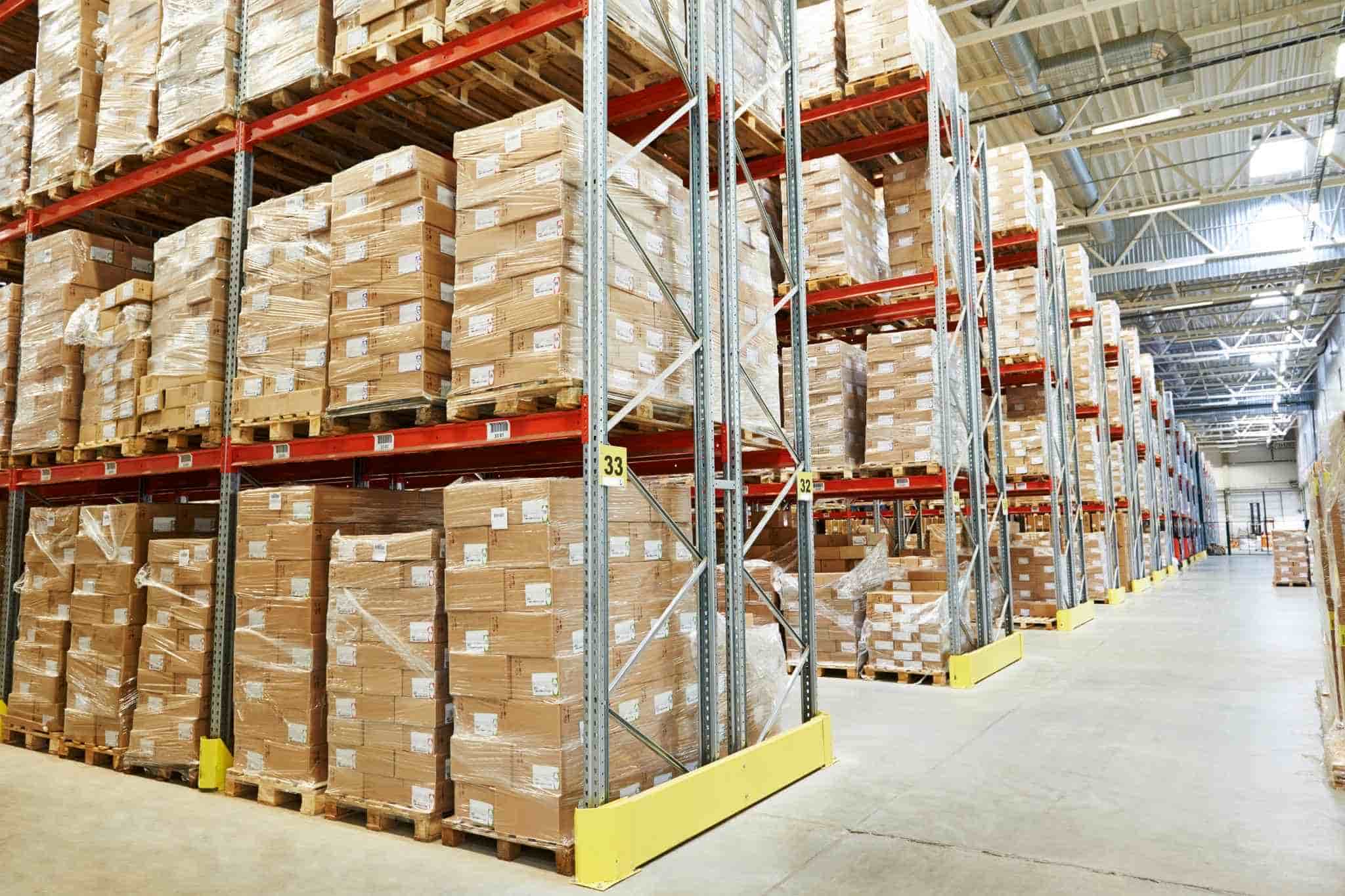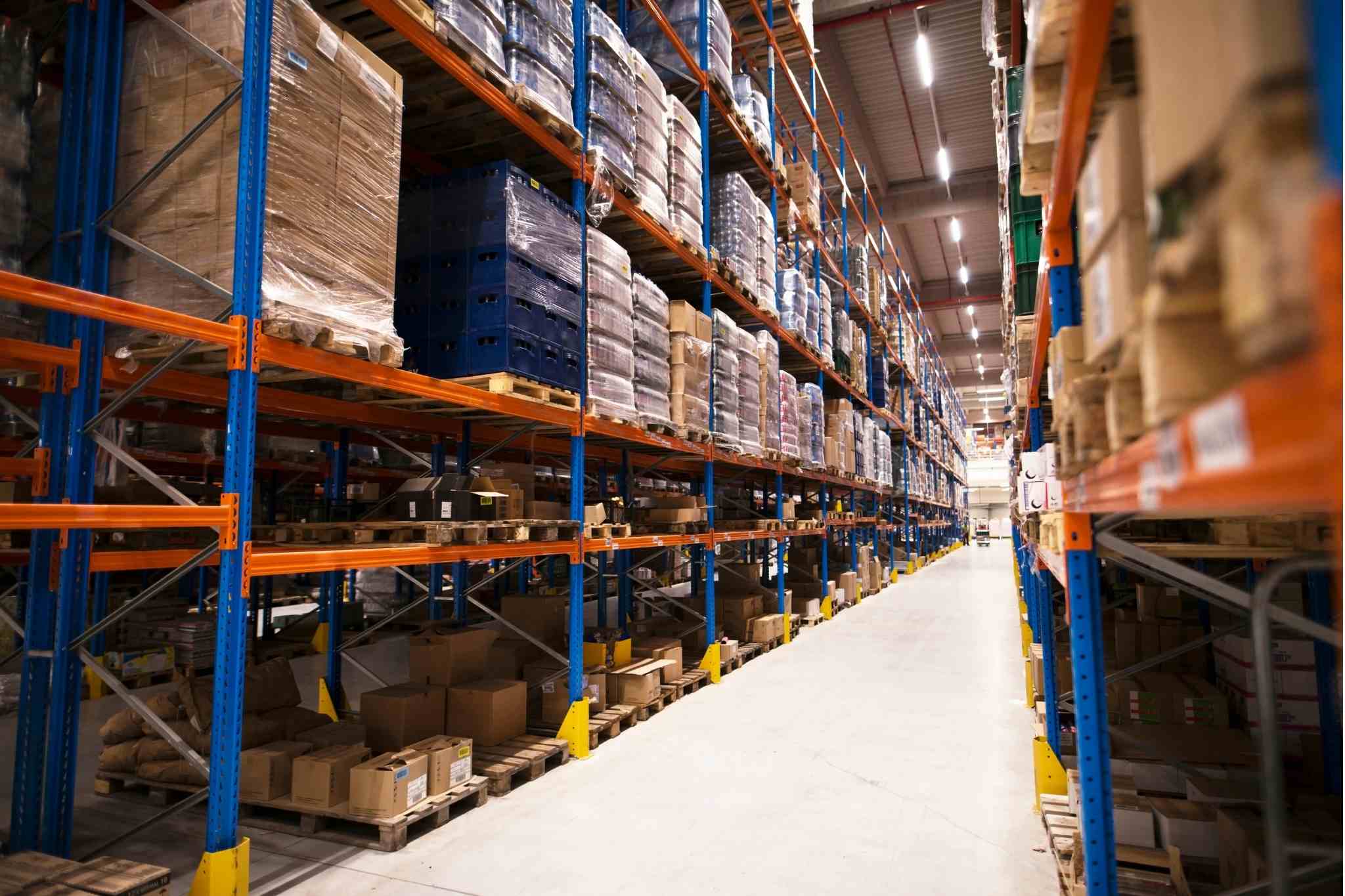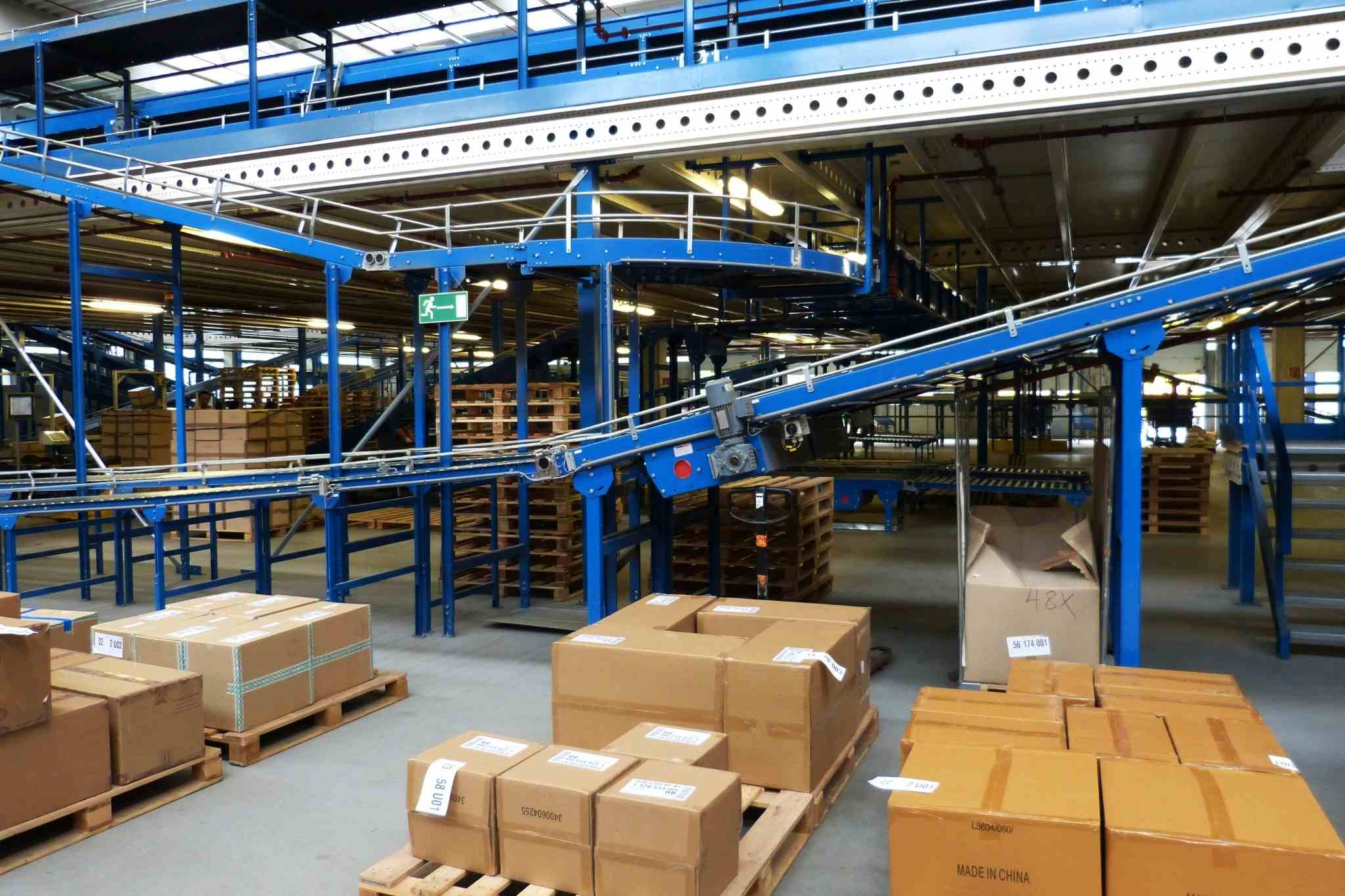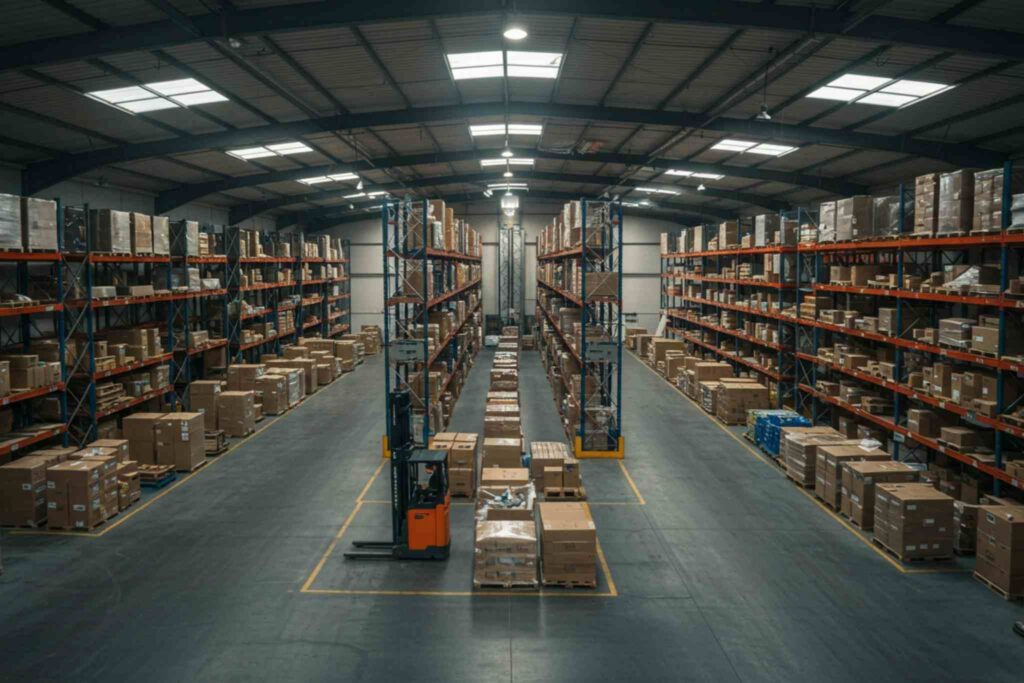Table of Contents
Key Takeaways✔ A logistics warehouse is a facility designed to store, manage, and distribute goods as part of a supply chain, improving efficiency and inventory control. ✔ Logistics warehouses streamline distribution by optimizing inventory management, speeding up order fulfillment, and reducing transportation costs through strategic location and automation. ✔ Modern logistics warehouses use technologies such as Warehouse Management Systems (WMS), automated picking tools, and IoT to improve accuracy, efficiency, and real-time visibility in operations. ✔ Optimizing storage space in a logistics warehouse involves using vertical storage, adjustable shelving, narrow aisles, and automation to maximize space utilization and improve efficiency. |
Logistics warehouses are key facilities in the supply chain, designed to store and manage products before they reach their destination. They ensure that goods are available and ready for distribution at the right time, helping to streamline the overall flow of products. As the global warehousing market grows, projected to reach USD 1.73 trillion by 2030, these warehouses are becoming increasingly crucial in meeting the rising demands of fast and efficient distribution. This growth reflects the expanding role of logistics warehouses in improving supply chain efficiency and reducing operational costs.
Here are several ways these warehouses contribute to smooth operations.

What Is a Logistics Warehouse?
A logistics warehouse is a facility specifically designed for the storage and management of goods and materials that are part of a supply chain. These warehouses are critical in ensuring that products are available at the right time and in the right place, contributing to the overall efficiency of the supply chain process.
Types of Logistics Warehouses
There are several types of logistics warehouses, each serving different purposes based on the needs of the business and its supply chain.
- Public Warehouses: These warehouses are operated as independent businesses and offer storage space to multiple clients. Companies that do not want to invest in their own warehouse facilities often use public warehouses. This type of warehouse is ideal for businesses with fluctuating storage needs. “What is a logistics warehouse and how does it function in supply chains?” can be better understood through public warehouses as they provide flexible and temporary storage solutions for businesses without the need for significant investment in infrastructure.
- Private Warehouses: These are owned and operated by a single company for its exclusive use. Private warehouses are suitable for businesses that require constant storage or have large volumes of inventory. They offer greater control over inventory management and are often found in larger companies.
- Distribution Warehouses: Designed primarily for the purpose of moving goods to various locations, distribution warehouses are used to store products temporarily before they are sent out to retailers or customers. These warehouses play a vital role in ensuring that products are distributed efficiently and quickly.
- Fulfillment Warehouses: These warehouses focus on fulfilling customer orders directly, particularly for e-commerce businesses. They store products and process customer orders, including packaging and shipping. Fulfillment warehouses are increasingly important as online shopping continues to grow.
Industries That Rely on Logistics Warehouses
Logistics warehouses are used across many industries to manage the storage and distribution of products. Each industry has its unique needs, which influence the design and operations of its warehouses.
- E-commerce and Retail: E-commerce companies rely on fulfillment and distribution warehouses to store products and quickly ship them to customers. The fast-paced nature of online shopping means that these businesses must maintain highly efficient warehouses to meet customer expectations for quick delivery times.
- Manufacturing: Manufacturers use logistics warehouses to store raw materials and finished products. These warehouses ensure that inventory is readily available when needed, helping to streamline production processes and maintain consistent product supply.
- Automotive: In the automotive industry, warehouses play a key role in storing parts and components that are necessary for vehicle assembly. Distribution centers for car manufacturers ensure that parts are delivered on time to assembly plants, minimizing production delays.
- Food and Beverage: The food and beverage industry often requires specialized warehouses for storing perishable goods. Temperature-controlled facilities are crucial for maintaining product quality and freshness, especially for goods that require refrigeration or freezing.
- Pharmaceuticals and Healthcare: Pharmaceutical companies rely on warehouses to store medicines, medical devices, and other healthcare products. These warehouses often require strict regulatory compliance to ensure that products are stored and handled safely, maintaining the quality and efficacy of medical supplies.
How Do Logistics Warehouses Streamline Distribution Operations?
Logistics warehouses play a vital role in streamlining distribution operations by improving efficiency, reducing costs, and ensuring timely deliveries. They are designed to handle the storage and movement of goods, often managed by a trusted logistics company, making the entire supply chain process smoother. When a company understands what a logistics warehouse is and how it functions in supply chains it becomes clear how these facilities contribute to faster and more organized distribution.
Efficient Inventory Management
Logistics warehouses are equipped with advanced systems and processes that help track and manage inventory in real time. These systems ensure businesses can maintain accurate stock levels and avoid both shortages and excess inventory. This capability directly answers how do logistics warehouses streamline distribution operations? by providing real-time inventory management, which helps optimize stock levels and reduce inefficiencies in the supply chain.
- Inventory Control Systems: These systems help warehouses monitor every item stored and allow businesses to have a clear view of stock at any given time. With real-time updates, companies can make informed decisions about purchasing, stocking, and selling.
- Reduced Stockouts and Overstocking: Efficient inventory control ensures businesses don’t face stockouts, which can lead to missed sales, or overstocking, which ties up valuable resources. This balance helps improve both profitability and operational efficiency.
Faster Order Fulfillment
Logistics warehouses streamline order fulfillment by ensuring a quick and accurate picking process. The more streamlined the picking system is, the faster products can be shipped to customers. When businesses can fulfill orders quickly, they reduce the chances of delays, thus maintaining customer satisfaction.
- Order Picking Systems: These systems enable warehouse workers to retrieve products quickly, either manually or using automation. They help speed up the process by guiding staff to the correct locations and minimizing the time spent searching for items.
- Centralized Location: Many logistics warehouses are strategically located near transportation hubs or major customer markets. This proximity allows for faster shipping and helps reduce transportation costs, making delivery times shorter and more reliable.
Cost-Effective Operations
Logistics warehouses help businesses save money by maximizing storage efficiency and reducing unnecessary operational costs. This is achieved through better space management, workforce optimization, and strategic use of technology. Efficient warehouse operations lead to reduced overall costs in the supply chain, benefiting the company’s bottom line.
- Optimized Storage Solutions: By organizing goods in an efficient manner, logistics warehouses can store more items in a smaller area. This optimizes storage costs and allows for a higher volume of products to be managed without requiring additional space.
- Lower Transportation Costs: Lower Transportation Costs: By positioning warehouses closer to major distribution points or customer bases, businesses can significantly reduce transportation expenses. This reduces the need for long-distance shipments and helps improve delivery speed. This is a key factor in answering how do logistics warehouses streamline distribution operations? by cutting transportation costs and enhancing the overall efficiency of the distribution process.
Use of Technology
Technology plays a huge part in streamlining logistics warehouse operations. Automation and warehouse management systems (WMS) ensure that processes are faster, more accurate, and more efficient. With the right technology in place, businesses can track every aspect of their inventory and shipments, improving both speed and accuracy.
- Warehouse Management Systems (WMS): These systems provide businesses with real-time data on inventory levels and order status. By automating tasks like stock tracking and order processing, WMS minimizes human errors and enhances overall efficiency.
- Automation: Robotics, conveyor belts, and automated sorting systems help move products through the warehouse quickly and without errors. The use of automation speeds up processes, reduces labor costs, and improves overall distribution efficiency.
Enhancing Customer Satisfaction
By streamlining operations, logistics warehouses contribute directly to customer satisfaction through timely and accurate deliveries. A well-managed warehouse ensures that businesses meet customer expectations by delivering products in a reliable and efficient manner.
- Timely Deliveries: Efficient inventory management and streamlined order picking allow companies to fulfill orders quickly and on schedule. This is particularly important for customers who expect fast shipping, such as those purchasing from e-commerce platforms.
- Order Accuracy: With precise inventory control and order processing systems, logistics warehouses reduce the likelihood of shipping the wrong items. Accurate order fulfillment not only reduces returns but also builds trust with customers.
What Technologies Are Used in Modern Logistics Warehouses?
Modern logistics warehouses are adopting a variety of advanced technologies to boost operational efficiency, improve accuracy, and cut costs. These innovations help optimize storage, tracking, and distribution processes, allowing warehouses to better meet customer demands and respond to changing market conditions. A recent study shows that integrating more digital technologies into warehouse operations has the potential to transform business practices for the better, improving both productivity and overall performance.
1. Warehouse Management System (WMS)
A Warehouse Management System (WMS) serves as a central platform to manage all aspects of warehouse operations, providing real-time data and improving decision-making. It allows businesses to optimize workflows, reduce labor costs, and gain better visibility into inventory management. Understanding what technologies are used in modern logistics warehouses? helps highlight the importance of a WMS as it improves operational efficiency and ensures better control over warehouse processes.
- Real-Time Visibility: A WMS gives instant access to data, enabling businesses to track inventory and monitor warehouse activities efficiently.
- Cost Reduction: By automating labor allocation and streamlining processes, a WMS lowers labor expenses and increases operational efficiency.
- Improved Accuracy: WMS enhances inventory control and reduces errors in picking and storing goods, which leads to better customer service.
2. Automated Picking Tools
Automated picking tools have transformed the way items are selected and prepared for shipment in high-volume warehouses. These systems reduce human errors, increase picking speed, and improve overall productivity by automating the selection process.
- Voice-Activated Picking: Using voice commands, workers can efficiently pick items without needing to refer to written instructions, boosting accuracy and speed.
- Pick-to-Light Systems: These systems direct workers to specific items using lights, allowing them to quickly retrieve products, improving pick rates and reducing errors.
3. Automated Guided Vehicles (AGVs)
Automated Guided Vehicles (AGVs) are self-guided machines used to transport goods within the warehouse, reducing the need for manual labor. These vehicles follow predetermined paths and can handle tasks such as loading, unloading, and stock retrieval, optimizing the flow of goods.
- Increased Efficiency: AGVs help streamline the movement of goods, speeding up processes like putaway and stocktaking, while reducing manual labor.
- Scalable and Flexible: As business needs grow, AGVs can be added to increase warehouse capacity and improve operational flexibility without redesigning the entire layout.
4. Automated Inventory Control Platforms
Automated inventory control platforms allow businesses to track and manage their stock with minimal manual effort. These platforms use tags and real-time data to automatically update inventory levels, helping prevent errors and improve accuracy in stock management. This technology is crucial in answering what technologies are used in modern logistics warehouses? by automating stock tracking and ensuring more precise inventory control.
- Efficient Stock Tracking: These systems offer real-time updates, allowing warehouse managers to have an accurate picture of inventory at all times.
- Reduced Manual Errors: Automated counting and tracking eliminate the need for pen-and-paper processes, which can lead to data inconsistencies and mistakes.
5. Internet of Things (IoT)
The Internet of Things (IoT) connects various devices, sensors, and systems throughout the warehouse, enabling real-time monitoring of operations. IoT technology provides valuable insights into environmental conditions, product movement, and equipment performance, leading to better decision-making and enhanced risk management.
- Environmental Monitoring: IoT sensors track factors like temperature and humidity, ensuring that products are stored under optimal conditions.
- Supply Chain Visibility: By gathering data from products, vehicles, and equipment, IoT technology provides a comprehensive view of the supply chain, reducing the risks of theft, damage, or spoilage.

How to Optimize Storage Space in a Logistics Warehouse?
Optimizing storage space in a logistics warehouse is crucial for boosting efficiency and cutting costs. With limited space, it’s essential to use every inch effectively while maintaining easy access and smooth operations. Below are six ways to optimize storage space in a logistics warehouse, helping to streamline processes and improve productivity.
1. Utilize Vertical Space
One of the most effective ways to optimize storage space in a logistics warehouse is by making full use of vertical space. Installing higher shelving and racking systems allows businesses to store more goods without expanding the floor area, improving storage capacity and organization.
2. Implement Adjustable Shelving
Adjustable shelving systems are key in making better use of warehouse space. These systems offer flexibility to accommodate various product sizes, helping to optimize the layout as inventory needs change. This method ensures the warehouse adapts to different stock levels and reduces unused space.
3. Use Narrow Aisles
Narrow aisles, paired with high-density racking systems, allow for more goods to be stored in less space. This setup increases storage capacity and improves warehouse efficiency. It plays a key role in how to optimize storage space in a logistics warehouse? by utilizing available space without compromising accessibility.
4. Optimize Floor Layout
An efficient floor layout is vital to optimizing storage space in a logistics warehouse. Organizing racking systems, aisles, and workstations in a way that minimizes wasted space allows for smoother operations and better space management, making it easier to access goods quickly.
5. Implement Automated Storage Systems
Automated Storage and Retrieval Systems (ASRS) can greatly optimize storage space by automating the storage and retrieval of items. This technology reduces the need for extra space and increases the density of inventory storage, providing a streamlined process for managing warehouse goods.
6. Optimize Product Size Organization
Grouping products based on size and type can make better use of available space. By storing similar-sized items together, businesses can reduce empty space and maximize storage efficiency. This strategy directly answers how to optimize storage space in a logistics warehouse? by improving organization and ensuring that every space is effectively utilized.
Frequently Asked Questions
What is the basic purpose of supply chain management?
The basic purpose of supply chain management is to efficiently manage the flow of goods, services, and information from suppliers to consumers. It ensures that the right products are delivered at the right time and cost, while minimizing waste and optimizing resources. Effective supply chain management improves overall business performance, enhances customer satisfaction, and reduces operational costs.
How to streamline an inventory process?
To streamline an inventory process, businesses can implement an automated system that tracks stock in real time. This helps reduce errors and ensures inventory levels are maintained accurately. Additionally, adopting just-in-time inventory and optimizing warehouse layouts can improve the speed and accuracy of stock management, making the overall process more efficient.
How can we strengthen the supply chain?
Strengthening the supply chain involves improving communication and collaboration across all partners and stakeholders. Companies can also diversify their supplier base to reduce risks and implement technology solutions for better visibility and real-time data sharing. Building flexibility and resilience into the supply chain, such as with alternative sourcing or contingency plans, further strengthens its effectiveness.
What are the key elements of a successful supply chain?
The key elements of a successful supply chain include effective planning, efficient procurement, strategic sourcing, reliable transportation, and seamless logistics. These elements work together to ensure that products are delivered on time, at the right cost, and in optimal condition, which helps maintain a competitive edge in the market.
How can supply chain risk be minimized?
Supply chain risk can be minimized by diversifying suppliers, having contingency plans, and implementing predictive analytics to identify potential disruptions. Regular monitoring of external factors such as geopolitical issues, weather events, or market trends can also help companies stay ahead. Additionally, building strong relationships with reliable partners and investing in flexible logistics systems can further mitigate risks and ensure business continuity.

Optimize Supply Chain Efficiency with Warehouse Logistics By Best in New York, NY!
Warehouse Logistics By Best offers expert solutions tailored to enhance supply chain performance in New York, NY. With comprehensive services focused on improving inventory management, storage, and distribution processes, businesses can experience smoother, more efficient operations. Trusted by companies across New York, NY, Warehouse Logistics By Best provides scalable, reliable solutions to meet the evolving needs of any supply chain.
Ready to get started? Reach out today to learn how our services can support and improve business operations in New York, NY!

